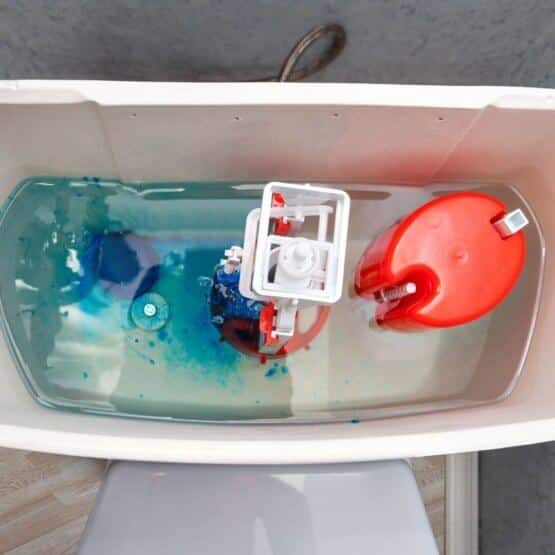Most of us take our toilet bowl for granted. In the end, no one likes spending more time cleaning it than we have to. This is why seeing brownish water coming into the freshly cleaned bowl can bring us to the edge of tears. Luckily, brown water in toilet after flushing typically doesn’t mean the water on your property is toxic or harmful.
Brown water in toilet after flushing is usually just a common piping problem. It could be caused by iron in water or just simply by dirty brown well water.
It may, however, require help from a professional on most occasions.
If you want to know what causes brown water in toilet, this article is for you.
What Causes Brown Water In Toilet

Before you go on, flush your toilet once again. Sometimes, you may simply have a lot of residues that will go away. One flush often can’t eliminate the waste entirely, and the flush cycle needs to end completely.
If there is still brown water in toilet, don’t worry, feces don’t cause this. Nevertheless, you have to fix the source of it.
To find out what causes brown water in toilet, first, you have to check other water sources in your house. Look at the water from all sinks, tub, and any other tap you may have.
Make sure to check both cold and hot water. This is the key to finding out what is the cause of brown water in toilet. You’ll be left with two options.
There Is Brown Water in All Your Water Sources
There is a chance that there is brown reddish water in all of the water sources you’ve checked. If the water from the taps looks dirty as well, you may have too much iron in it. [1]
There are other signs of too much iron that you may have noticed, without realizing the connection between the two.
Some of them include dark stains on your clothes or a swamp-like smell all-around your water sources. Often, when it has too much iron, tap water can taste like metal.
Iron in the pipes is common in homes that have plumbing systems installed before the 1960s.
These pipes were commonly made from galvanized steel that tends to corrode when in contact with water and oxygen.
These two can make iron to rust, and that rust will sooner or later get into the tap water. In fact, corroded iron pipes are the most common reason behind brown water found in the home.
Modern pipelines are mostly made from PVC and similar materials that aren’t prone to corrosion. This is why newer homes rarely have a brown water problem.
There Is Brown Water in Toilet Only
If there is brown water in toilet, but other water sources are looking fine… the problem is probably still corroded pipes. It isn’t rare for bathrooms to have their own water pipes.
Even though the water is coming from the same source, different taps may be made from different materials.
Toilet pipes are commonly made of galvanized steel even today, while other pipes are made of PVC.
This is why taps or tubs aren’t affected. Not only that, but there is a chance that only that one specific pipe has corroded, while others are fine.
This is why the water in the toilet is brown, but the sinks are all right.
If the water in your household comes from a well, you may have some dissolved organic matter in it. If this is the case, the brown color is typically accompanied by some sort of sediment.
If you notice any of these two issues, you have to check your well.
Maybe you have a broken or dirty pump filter, which can allow dirt to enter pipes.
In that case, replace old filters with new ones.
There is a chance the well itself has been breached. If you recently had storms or some construction projects in the area, this may be the cause of brown water.
Dirty well can be harmful to your health, so don’t delay your local plumber’s visit!
How to Get Rid of Brown Water in Toilet Tank?

It’s annoying always to have to look at that brown water in toilet after flushing. Luckily for you, the problem isn’t unfixable.
Before calling the plumber, you may try installing a good water softening system. This can help with most residue, and it may solve your problem painlessly.
Most water softeners remove iron, as well as other hard minerals. If you have brown water in all your taps, this can be a great solution.
Keep in mind that professionals should install water softeners. And don’t worry – once the water is back to its standard color, it will usually be safe for drinking.
If this doesn’t assure you, install a water filter and purifier, as well.
Before installing the softener, you should test the iron levels to know how bad a problem you have. You can buy iron level testing kits in most hardware stores.
You can also call a plumber to test the water for you. This will cost more, but a professional can give you a detailed overview of the situation and more precise results.
If you test the water by yourself, there is always a chance you may not do it correctly. Cheap tests tend to be faulty, as well.
There are also chemical treatments created to lower the amount of iron and bacteria in the water. These treatments vary in efficiency and price, but they tend to be cheaper than the cost of softener installing.
Higher iron levels can complicate things a bit, as most filters can’t lower them to a safer level. If you notice the iron level is too high, you may want to install an aeration system. [2]
The aeration system will change the structure of the iron, making its molecules bigger. This will make it easier for water filters to eliminate iron from your water.
Many people suggest using Chlorine for removing the brown water in toilet. Chlorine will kill iron bacteria, making your water safe to drink. However, it won’t remove the iron itself. [3]
When none of these methods seems to work, the only option remaining is to replace all corroded pipes. If most of your house has PVC pipes, you’ll probably only have to replace the toilet pipes.
In other cases, all the pipes in your home have to go. Replacing the pipes is expensive, but in this case, it is a necessity. Corroded pipes can leak and damage the structure of your home.
Can You Prevent Pipes from Corroding?
If you have PVC pipes, then corrosion isn’t something that should worry you. Galvanized steel pipes, on the other hand, will corrode in time sooner or later.
Using water filtration systems before the problem occurs will prevent iron levels from raising. However, the pipes may still corrode without you knowing.
Regularly maintaining the pipes is the best way to prolong their life span. The better care you take of your plumbing system, the lower are the chances of brown water appearing.
There is no exact rule to this, however, and the pipes may still corrode whatever you do.
Is Iron in Water Dangerous?

If you’ve drunk brown water from your tap by accident, don’t panic. Even though this is gross, it isn’t really dangerous. Iron is an essential mineral for our bodies, and as such, it isn’t toxic by itself.
If you leave a bicycle or some metal object outside in the rain, it will rust. That same rust is what is causing the water discoloration.
However, even smaller amounts of iron in water can damage pipes.
The rust will create mineral deposits, and pipes may leak as rust is, essentially, destroying the metal.
All of this can cause various plumbing issues, such as slow draining or reduced water pressure. [4]
Keep in mind that ongoing, excessive drinking of water with high amounts of iron can have some negative effects. These effects include:
- Poor skin
- Iron overload
- Damaged liver
- Damage to heart and pancreas
Even smaller iron levels can leave a metallic taste in your mouth after consuming anything made with tap water.
This can significantly reduce the quality of your food and drinks.
If you notice a metallic taste after drinking water, call your plumber to check iron levels.
Bottom Line
If you notice brown water in toilet, you shouldn’t panic or feel disgusted. The water isn’t dirty because of the remaining bodily fluids, and it isn’t toxic.
Brown water is caused by the rusty residue that comes with galvanized steel pipes, which are commonly used even today.
However, having brown water in toilet appear after flushing is usually a sign of a much bigger problem.
Even though you won’t experience any negative effects, for now, having high iron levels in the water can cause damage.
If you leave this problem to persist, you are risking damaging the plumbing in the entire house! And if the tap water is brown, as well, you may risk your health in the long run, as well.

Michael Davis is a heating & plumbing expert who currently works as independent contractor in SC. He also writes for Plumbertip.
For almost 10 years he worked on various plumbing tasks across South Carolina.


